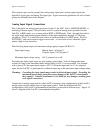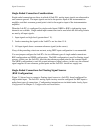
Signal Connections Chapter 3
Lab-PC+ User Manual 3-6 © National Instruments Corporation
the measured input signal varies or appears to float. An instrument or device that provides an
isolated output falls into the floating signal source category.
Ground-Referenced Signal Sources
A ground-referenced signal source is one that is connected in some way to the building system
ground and is therefore already connected to a common ground point with respect to the
Lab-PC+, assuming that the PC is plugged into the same power system. Non-isolated outputs of
instruments and devices that plug into the building power system fall into this category.
The difference in ground potential between two instruments connected to the same building
power system is typically between 1 mV and 100 mV but can be much higher if power
distribution circuits are not properly connected. The connection instructions that follow for
grounded signal sources are designed to eliminate this ground potential difference from the
measured signal.
Input Configurations
The Lab-PC+ can be configured for one of three input modes–NRSE, RSE, or DIFF. The
following sections discuss the use of single-ended and differential measurements, and
considerations for measuring both floating and ground-referenced signal sources. Table 3-1
summarizes the recommended input configurations for both types of signal sources.
Table 3-1. Recommended Input Configurations for Ground-Referenced
and Floating Signal Sources
Type of Signal Recommended Input Configuration
Ground-Referenced
(non-isolated outputs,
plug-in instruments)
DIFF
NRSE
Floating
(batteries, thermocouples,
isolated outputs)
DIFF with bias resistors
RSE
Differential Connection Considerations (DIFF Configuration)
Differential connections are those in which each Lab-PC+ analog input signal has its own
reference signal or signal return path. These connections are available when the Lab-PC+ is
configured in the DIFF mode. Each input signal is tied to the positive input of the
instrumentation amplifier, and its reference signal, or return, is tied to the negative input of the
instrumentation amplifier.


















